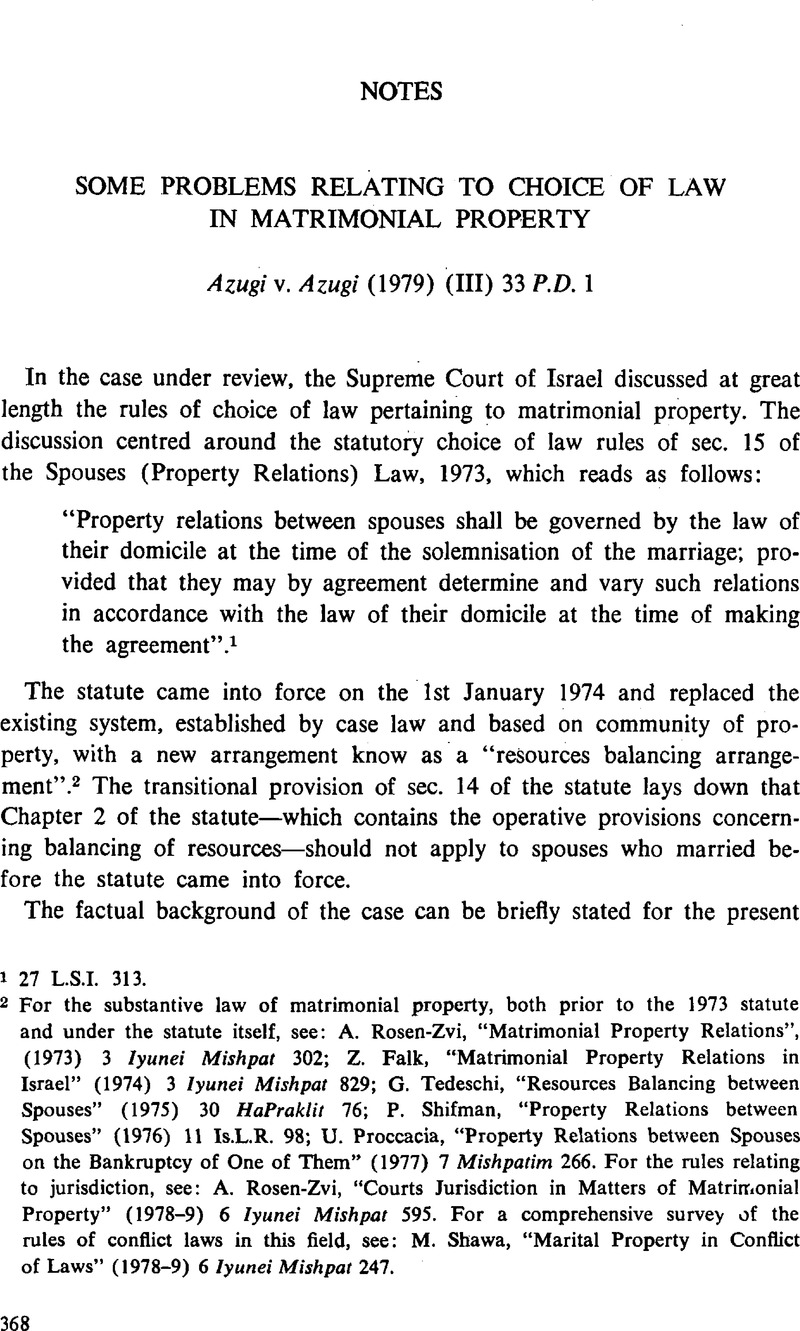No CrossRef data available.
Article contents
Some Problems Relating to Choice of Law in Matrimonial Property
Published online by Cambridge University Press: 12 February 2016
Abstract

- Type
- Notes
- Information
- Copyright
- Copyright © Cambridge University Press and The Faculty of Law, The Hebrew University of Jerusalem 1981
References
1 27 L.S.I. 313.
2 For the substantive law of matrimonial property, both prior to the 1973 statute and under the statute itself, see: Rosen-Zvi, A., “Matrimonial Property Relations”, (1973) 3 Iyunei Mishpat 302 Google Scholar; Falk, Z., “Matrimonial Property Relations in Israel” (1974) 3 Iyunei Mishpat 829 Google Scholar; Tedeschi, G., “Resources Balancing between Spouses” (1975) 30 HaPraklit 76 Google Scholar; Shifman, P., “Property Relations between Spouses” (1976) 11 Is.L.R. 98 Google Scholar; Proccacia, U., “Property Relations between Spouses on the Bankruptcy of One of Them” (1977) 7 Mishpatim 266.Google Scholar For the rules relating to jurisdiction, see: Rosen-Zvi, A., “Courts Jurisdiction in Matters of Matrimonial Property” (1978–9) 6 Iyunei Mishpat 595.Google Scholar For a comprehensive survey of the rules of conflict laws in this field, see: Shawa, M., “Marital Property in Conflict of Laws” (1978–9) 6 Iyunei Mishpat 247.Google Scholar
3 These differences, as enumerated by Elon, J., are briefly as follows: a) English law refers to the domicile of the husband at the time of solemnization of the marriage, whereas sec. 15 refers to the law of domicile “of the spouses”; b) English law has different rules for immovable and movable property, whereas sec. 15 makes no such distinction; c) Under English law, a change of domicile of the spouses results in a change in the law applicable to their property relations, subject to protection of vested rights. Sec. 15, on the other hand, does not provide for an automatic change in the applicable law following a change in domicile.
4 See, however, Article 21 of the Hague Convention on the Law Applicable to Matrimonial Property Régimes 1976 which states as follows: “The Convention applies, in each Contracting State, only to spouses who have married or who designate the law applicable to their matrimonial property régime after the Convention enters into force for that state”. For text of this Convention, see (1977) 16 International Legal Materials 14.
5 And see Shawa, M., “Marital Property in Conflict of Laws” (1978–9) 6 Iyunei Mishpat 247 Google Scholar, at 263–265.
6 For this presumption in Israeli law, see especially: Yazdi v. Yazdi (1951) 4 P.D. 762; Rapaport v. Feldbrovsky (1950) 4 P.D. 645; Yachimovitz v. Rubashilz (1956) 10 P.D. 1044; Pacific-Mediterranean Line v. Taasiot Eretz-lsrael (1955) 9 P.D. 1779.
7 Albeit for differing reasons—Elon, J., by process of literal interpretation of the section, and Barak, J., in view of the need to protect vested rights.
8 Cf. however Article 11 of the Hague Convention: “The designation of the applicable law shall be by express stipulation, or arise by necessary implication from the provisions of a marriage contract”.
9 See e.g., Shawa, op. cit., supra n. 2 at pp. 270 and 272, for the Israeli viewpoint.
10 Ehrenzweig, and Jayme, , Private International Law, Vol II—Special Part (1973) 208.Google Scholar
11 [1900] A.C. 21.
12 But see Sykes, and Pryles, , Australian Private International Law (1979) 506.Google Scholar The authors' view that “English attitudes seem to favour the doctrine of immutability” is apparently based on their contention that “the theory of giving effect to vested rights is merely an expression of opinion in favour of the immutability doctrine”. According to Leflar, , American Conflicts Law (3rd ed., 1977) 475 Google Scholar, American law generally favours immutability. This is so apparently also in Holland. See Ploeg, van der, “The Netherlands Supreme Court and International Property Law” (1977) 24 Netherlands International L.R. 474 CrossRefGoogle Scholar, 488.
13 Morris, J.H.C., The Conflict of Laws (2nd ed., 1980) 359.Google Scholar
14 Dicey, and Morris, , The Conflict of Laws (10th ed., 1980) Vol. II, p. 670 Google Scholar—Rule 116 and comment thereon. See also: Cheshire, and North, Private International Law (10th ed., 1979) 579.Google Scholar
15 Morris, op. cit., supra n. 13, at 360.
16 A number of other problems in the field of choice of law in matrimonial property did not directly arise in the present case and will consequently not be considered here. Ehrenzweig refers to the initial dilemma as to whether to characterize the field of matrimonial property as one of personal or of proprietary relations (Ehrenzweig and Jayme, op. cit., supra n. 10 at 200). The Israeli rule as stated in section 15 of the statute is based on the personal law, thus assuming that matrimonial property is part of the law of marital relations rather than that of property, and this is also the basic approach of the Hague Convention. Mention may also be made of the following issues: should a uniform law be applied to movables and immovables or separate laws to each category? (This question was referred to by Barak, J., who preferred the first alternative.) Is the reference to a particular legal system in this context a reference to the internal law of that system, or should renvoi apply?




